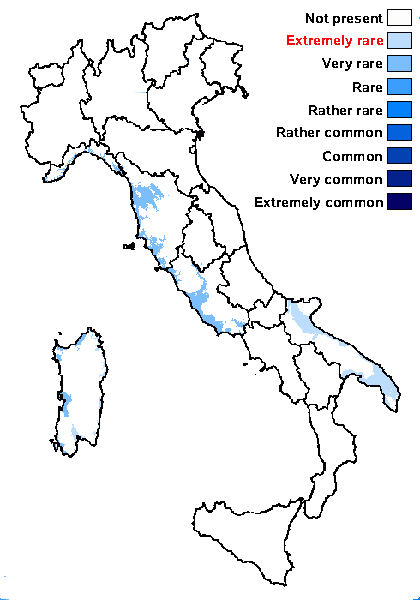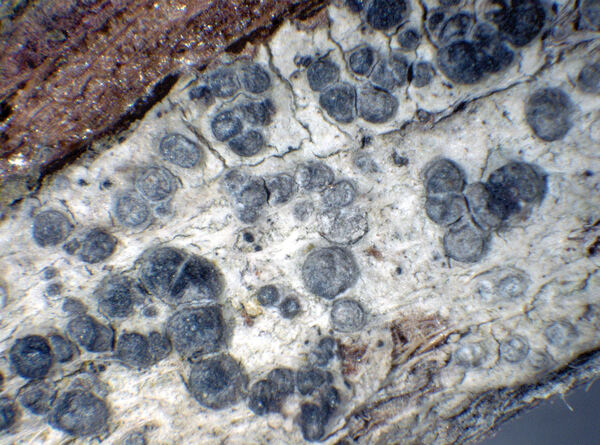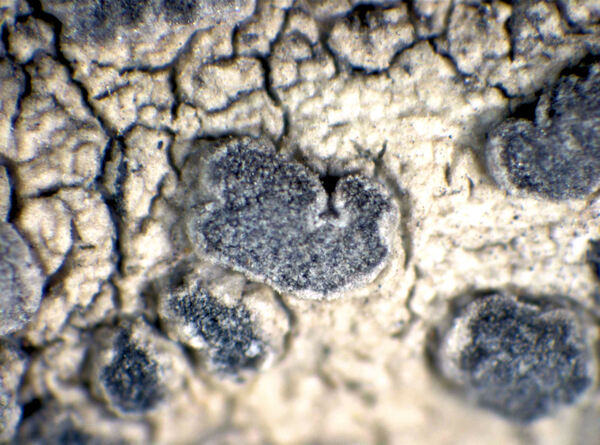Diromma dirinellum (Nyl.) Ertz & Tehler
in Ertz & al., Fungal Divers., 70: 41, 2014. Basionym: Platygrapha dirinella Nyl. - Mém. Soc. Sc. Nat. Cherbourg, 4: 95, 1856.
Synonyms: Lecania diplotommoides Bagl.; Platygrapha diplotommoides (Bagl.) Jatta; Schismatomma diplotommoides (Bagl.) Samp.; Schismatomma diplotommoides var. crenulatum B. de Lesd.; Schismatomma dirinellum (Nyl.) Zahlbr.
Distribution: N - Lig (Watson 2014). C - Tosc (SI 2733), Umb (Herb. Ravera 2606), Laz (Nascimbene & al. 2021), Sar. S - Pugl.
Description: Thallus crustose, whitish grey, at first poorly evident, then rimose-areolate, corticate, forming small patches on the thalli of Dirina ceratoniae. Apothecia 0.1-0.4(-0.6) mm across, round, oblong or irregular in outline, immersed to semi-immersed, sometimes confluent, with a dark brown to brown-black, often white-pruinose disc, a poorly evident proper margin, and a corticate, finally sometimes excluded thalline margin level with disc. Proper exciple very thin, inconspicuous; epithecium pale brown to greenish brown; hymenium colourless, I+ reddish; paraphysoids coherent, simple or sparingly branched in upper part, slender, c. 1.5 µm thick, the apical cells up to 3 µm wide; hypothecium colourless to pale brown, I+ blue. Asci 8-spored, clavate, bitunicate, the apex thickened with a small internal K/I+ blue ring. Ascospores 3-septate, hyaline, fusiform to ellipsoid with rounded ends, slightly curved, (18-)20-31 x 4-5.5 µm, without a perispore. Photobiont trentepohlioid. Spot tests: thallus K-, C-, KC-, P-. Chemistry: thallus with roccellic acid.Note: a rare species living as a parasite on Dirina ceratoniae, strictly confined to the Mediterranean belt. See also note on Ocellomma picconianum.
Growth form: Crustose
Substrata: bark
Photobiont: Trentepohlia
Reproductive strategy: mainly sexual
paras Dirina ceratoniae
Taxon bound to maritime-coastal situations
Commonnes-rarity: (info)
Alpine belt: absent
Subalpine belt: absent
Oromediterranean belt: absent
Montane belt: absent
Submediterranean belt: absent
Padanian area: absent
Humid submediterranean belt: absent
Humid mediterranean belt: very rare
Dry mediterranean belt: extremely rare

Predictive model
Herbarium samples
Growth form: Crustose
Substrata: bark
Photobiont: Trentepohlia
Reproductive strategy: mainly sexual
paras Dirina ceratoniae
Taxon bound to maritime-coastal situations
Commonnes-rarity: (info)
Alpine belt: absent
Subalpine belt: absent
Oromediterranean belt: absent
Montane belt: absent
Submediterranean belt: absent
Padanian area: absent
Humid submediterranean belt: absent
Humid mediterranean belt: very rare
Dry mediterranean belt: extremely rare

Predictive model
| Herbarium samples |
 INDEX FUNGORUM
INDEX FUNGORUM
 GBIF
GBIF
 DOLICHENS
DOLICHENS





